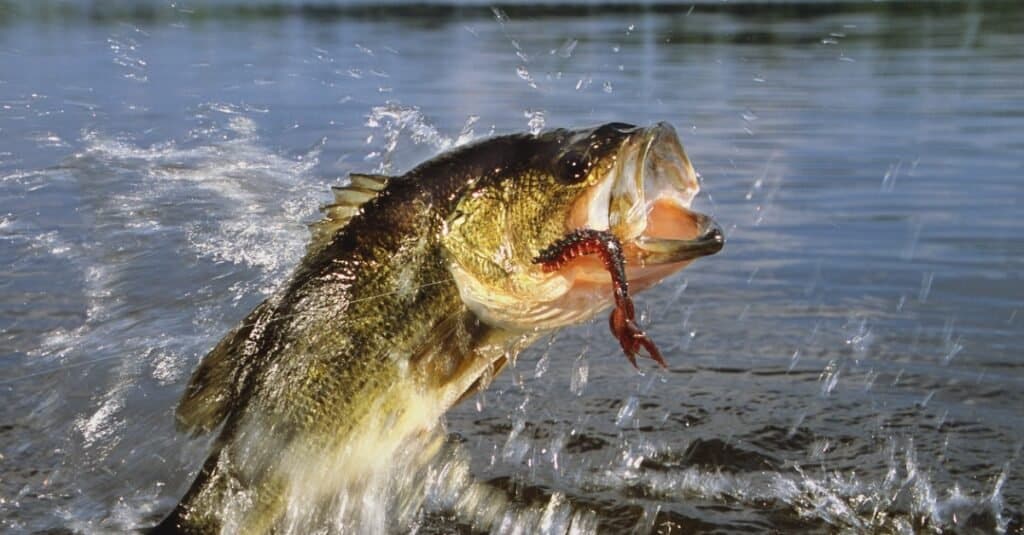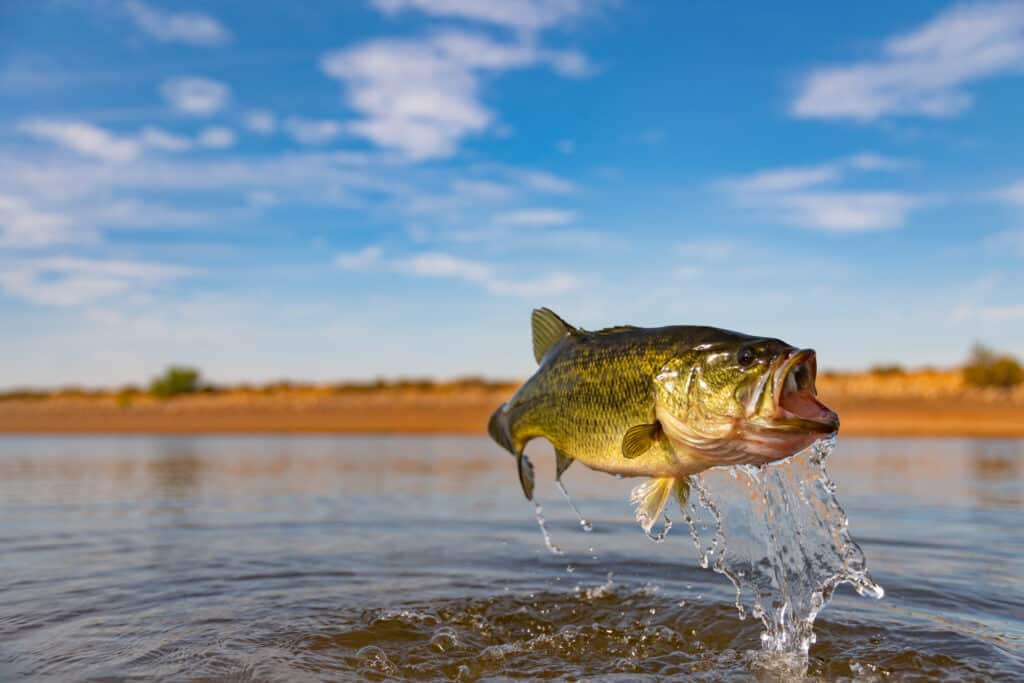Catching a record largemouth bass is an obsession for some, a passion for others, and a spectacle for the general public. The largemouth bass is unquestionably America’s most popular gamefish and a fascinating top predator, providing an excellent fight and reaching quite an impressive size. Of course, defining “trophy” is a personal matter that often differs depending on where you fish. A 10-pounder will raise eyebrows in the southern hemisphere; however, in most northern states, 6 pounds is deemed a monster.
For those who do not reside there, Indiana may not come to mind as a fishing destination, but there is excellent fishing available all year. So, how big do largemouth bass in Indiana really get, and what is the state’s record? This article uncovers the largest largemouth bass ever caught in Indiana plus some other interesting facts.
Largemouth Bass Facts
The largemouth bass is a sunfish that is one of North America’s most popular gamefish. Bluegills, crappies, and perch are also members of the sunfish family. Largemouth bass are distinguished by their enormous mouths, reaching past their eyes. They are known to be aggressive predators that prey on smaller fish, insects, and crayfish. They can devour prey that is more than half their own length! The largemouth bass is a popular gamefish because they fight hard when hooked and frequently evade capture due to their power and tenacity.
How Big Is the Largest Largemouth Bass Ever Caught in Indiana?

The biggest largemouth bass in Indiana was 14 pounds 12 ounces
©iStock.com/stammphoto
The state record for the largest largemouth bass caught in Indiana weighed 14 pounds and 12 ounces. Jenifer Schultz of Louisville, Kentucky, caught the Indiana state record largemouth bass on Memorial Day, May 27th, 1991, at Seven Springs Lake near Elizabeth, Indiana. It’s technically a private lake with little public access and only a ramp for community members. Schultz, the second female state record holder, caught this monster on a Rebel Pop-R P70 (the original), a 14-pound Berkley Trilene XT, and a Berkley Series One 5 1/2 foot pistol grip rod.
The True Story of Indiana’s Largest Largemouth Bass
Jenifer Schultz knew she’d hooked something exceptional the moment she saw the fish. Her husband arrived at the bank with a net in no time, and Schultz recalled not saying anything while fighting the fish. The enormous bass gave Schultz’s drag a workout two or three times, but the fish eventually got tired and came within range of the net.
It wasn’t an accident, nor was it done on purpose.
Jenifer Schultz was already an outstanding angler. She credits her spouse for introducing her to bass fishing ten years before her angling destiny date. Before their relationship, her fishing consisted almost entirely of pan fishing with her father. Jesse, her son, went on to fish for Indiana University, winning multiple collegiate fishing events, and currently works for the MLF Big 5.
How Big Can a Largemouth Bass Grow?

Largemouth bass can reach 30 inches long and weigh as much as 20 pounds!
©iStock.com/stammphoto
While the normal size of largemouth bass is between 13 and 20 inches long and one to five pounds, they can grow to be 30 inches long and weigh more than 10 pounds, if not 20 pounds. In most states, a largemouth bass weighing eight pounds or more is considered a trophy fish. In Indiana, largemouth grows at a rate of three to four inches each year for the first three years, then one to two inches yearly until age eight, and less than an inch yearly after that. Remember that these sizes are simply average and frequently vary greatly from fish to fish, population to population, and state to state!
Another intriguing fact is that female bass grow substantially larger than males, which is a fairly common phenomenon in the world of fish. Largemouth bass grow quickly during their first year, reaching an average length of six to eight inches and a weight of one-half to one pound, even though studies have shown that largemouth bass can weigh up to two pounds after their first year if they grow in optimal settings. The growth rate is determined by the largemouth bass’ range (remember, southern bass can grow twice as quickly as northern bass) and the amount of feed in their respective environments.
Where to Fish For Largemouth Bass in Indiana?
Largemouth bass can be found in almost every form of Indiana water bodies, such as ponds, lakes, reservoirs, streams, and rivers. Monroe Lake, Lake Patoka, Geist Reservoir, Lake Maxinkuckee, and Lake Michigan are among Indiana’s best bass fishing lakes.
Largemouth bass prefer warm, moderately clear waters with no discernible current. Aquatic vegetation and woody debris are essential components of high-quality largemouth bass habitats. The littoral zone is a shallow nearshore area with enough light to support aquatic vegetation growth. Submerged aquatic vegetation covers almost half of the littoral zone of a typical Indiana glacial lake, although vegetation is less common in reservoirs.
What Bait Catches the Biggest Bass?

It is best to use large lures when fishing for largemouth bass.
©Ryno Botha/Shutterstock.com
As a general rule, use a large bait to capture large fish. If they devoted their energy to it, the big fish would want a whole meal. Avoid using spinnerbaits and swimbaits; instead, use topwater frog lures, worms, crankbaits, or jigs.
Largemouth bass are opportunistic feeders, meaning they will sit back and wait for the right moment to strike a bait fish. Big bass are also slower and more in control, which means they don’t have to take every feeding opportunity that comes their way.
Use large lures and move them more slowly than usual. Anglers that use huge baits and a slow presentation to entice the big fish in the region may succeed in their usual spots. Don’t hesitate to venture into difficult-to-reach locations, dense vegetation, or murky-looking water.
Up Next:
The photo featured at the top of this post is © Ryno Botha/Shutterstock.com
Sources
- Indiana State Gov, Available here: https://www.in.gov/dnr/fish-and-wildlife/fishing/largemouth-bass/
- The Hunting Page, Available here: https://www.thehuntingpage.com/landing-the-big-one/
- Bass Online, Available here: https://bassonline.com/how-to-catch-bigger-bass/
Thank you for reading! Have some feedback for us? Contact the AZ Animals editorial team.






